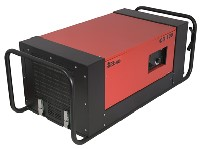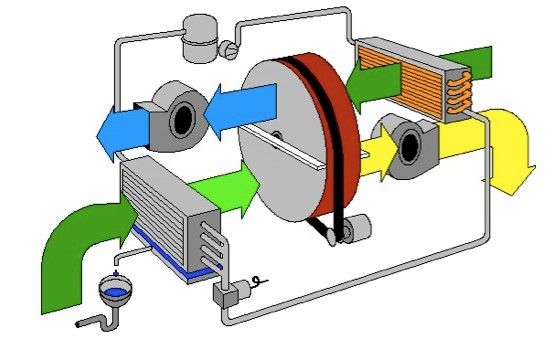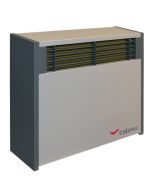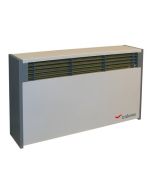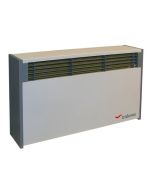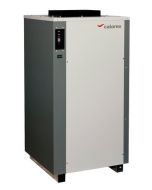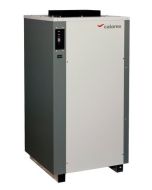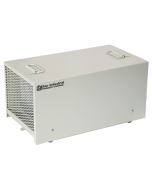Looking to browse wall mounted dehumidifiers from a UK stockist? Just click here to be taken to our range of dehumidifiers from Calorex, Dantherm and Ebac, or read on to learn more.
Wall mounted dehumidifiers. It is a bit of a misleading 'catch all' term, which actually covers a wide range of dehumidifiers which are designed in some way to be fixed, whilst some may indeed be wall mounted, others can be on a skid, or mounted through a wall, or on a shelf, or even over a door. This guide is intended to cover all these types of 'non mobile' dehumidifiers.
Effects of High Humidity
Higher humidity levels have far reach reaching effects on different materials. For example;
- corrosion
- condensation
- ceasing machinery because of corrosion
- ice damage following freezing of damp materials
- swelling (eg grains and wood)
- distortion (e.g. timber and furniture)
- moulds
- bacteria
- chemical instability
- slime
- discolouration
- reduction in shelf life
- loss of insulation properties
- increased energy use
- difficult handling in some materials
Stationary Dehumidifiers - Applications
Where the maintaining of humidity below a certain level is of permanent and critical importance, then it makes more sense to install a permanent dehumidification solution rather than to use a mobile unit.
Many products and materials are sensitive and susceptible to damage from humidity which is why permanent dehumidifiers are used in so many storage and production facilities. The following are just a few application areas of this type:
- books, records and archives
- food ingredients, including sugars, spices, grains
- metals stockholding
- timber and timber products
- engineering components
- electrical items
- powdered materials
- yeasts
- cargo
- pharmaceutical materials
- agricultural materials
- museums
- garages
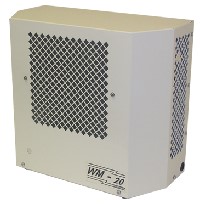
Ebac WM-20 wall mounted dehumidifier
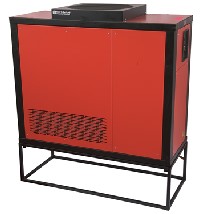
Ebac CD425 dehumidifier
Other applications can be found where the excess humidity can adversely affect or damage buildings, leisure and working environments these include:
- offices
- sports halls and gyms
- store rooms
- sub stations
- pumping stations
- basements/cellars
- drying rooms
- changing rooms
Although this page covers wall mounted dehumidifiers and other fixed types of dehumidifier, some of the more demanding applications and ones demanding exacting humidity control, fall within the scope of desiccant dryer which we cover in other pages.
What Is A Wall Mounted Dehumidifier?
In choosing a wall or floor mounted dehumidifier it is worth understanding what a dehumidifier does and how it removes moisture from the air. This is explained on another guide page, about portable industrial dehumidifiers.
Wall Mounted Dehumidifiers - Comparison of Performance
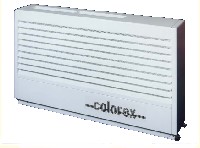
Calorex DH 75 wall mounted dehumidifier
Consideration should be given to the various points on the performance curve of a machine from which manufacturers will quote its performance. There is no industry standard on this and it is a frequent mistake to compare a dehumidifier with 50 litre per day (30°C, 90%RH) with another dehumidifier that boasts 50 litre per day (20°C, 70%RH).
These two machines do not have equivalent performance. The second machine will have a much higher performance than the first machine at all points on their performance curves. More about this and how to 'level the playing field' on the guide page about portable industrial dehumidifiers.
In contrast to mobile dehumidifiers where the usage is occasional rather than continuous, wall mounted and floor mounted dehumidifiers should also be compared on removal efficiency. That is to deduce for each dehumidifier, from the specifications how many watts of power is required to extract each litre of water.
This figure will depend on the ambient humidity and temperature, however once the potential dehumidifiers have been grouped according to those of similar performance at particular ambient conditions, you can then analyse the power consumption and operating cost for removing each litre of water. As you might expect, the more efficient wall mounted dehumidifiers will be the more expensive and vice versa.
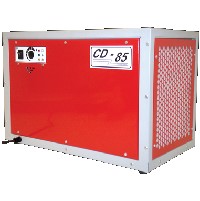
Ebac CD-85 stationary dehumidifier
Choosing An Industrial Wall Mounted Dehumidifier
In addition to comparing dehumidifiers performance you could also consider the following points:
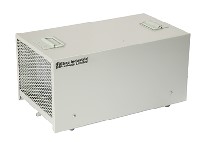
EbacCD30 wall mounted dehumidifier - ideal for drying rooms and laundries
Moisture Removal rate
It may seem obvious but maintaining a dry condition in a particular room using a dehumidifier that is a permanent fixture can normally be done with a modest removal rate, compared with the removal rate that you might prefer in a portable unit for drying out the same size room.
This is because the assumption behind a fixed dehumidifier is that it will be left on and under the control of its humidistat, and that it's operation is not to dry what is already very wet and humid, but to only to remove moisture as it ingresses the room.
Voltage and frequency
Permanently installed dehumidifiers will usually be powered by 230v single phase for small and medium size units, but on larger units 415v 3 phase will be required. With some applications a particular dehumidification duty may only be achieved using a number of smaller dehumidifiers rather than fewer 415V models, because of the power supply available.
It is always sensible to check the availability of power and its suitability to your dehumidification requirements before choosing a unit. Standard dehumidifiers operate on 50Hz supply, although sometimes applications will be offshore where 60Hz supply is normal. Many of the dehumidifiers that we supply have 60Hz variants suitable for these requirements.
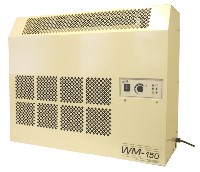
Ebac WM-150 stationary dehumidifier
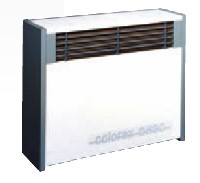
Calorex DH50 stationary dehumidifier
Size and Configuration
The actual size of the wall mounted dehumidifiers will be a factor, as will how it will be installed. Smaller units might be easily mounted on a wall whilst larger dehumidifiers will be designed for floor mounting. Larger units may also be wall mounted but will, if they have been designed as a floor mounted unit, require mounting on robust brackets, securely fitted to the wall.
With some models of wall mounted dehumidifiers, it is possible to have a through the wall configuration whereby the bulk of the unit is mounted on one side of the wall and dried air is delivered to the other side of the wall.
Operating Temperature
Consider the temperature range of the air that will be dehumidified. If there is any likely hood that the air will be below 10°C then it must have a defrost function and if it is likely to operate lower than 5°C then consider low temperature dehumidifiers. Ensure that the operating range of the dehumidifier covers the likely range in application.
Humidistat
Virtually all wall or floor mounted dehumidifiers will have an on board humidistat as the principle means of controlling the unit. It means that wall mounted dehumidifiers will operate whilst 'on' and the humidity is above the set point on the humidistat. If the humidity is lower than the set point then it should be off and then when the humidity subsequently rises above the set point, it will activate again.
With many models there is an option to have a remote humidistat. This is particularly useful for through the wall and wall mounted dehumidifiers where the machine itself may be out of reach or even in an adjacent room.
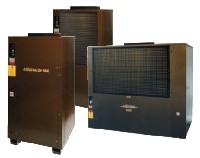
Calorex High Capacity Dehumidifiers
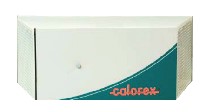
Calorex OTW15 wall mounted dehumidifier
Defrost
An essential feature for wall mounted dehumidifiers that operate in lower temperatures. Most wall mounted and floor mounted dehumidifiers will be equipped with hot gas defrost and for very low temperature models there will usually be a reverse cycle defrost.
Condensate Pump
Some wall mounted dehumidifiers will have a drain outlet, which for the majority of applications is fine particularly if the unit is wall mounted and there is plenty of fall to a drain.
If however the drain outlet of the dehumidifier does not have enough fall to the drain, if the drain run is long, or if the drain point is actually higher than the drain point on the unit, then look for a condensate pump on the dehumidifier to ensure that the condensates moves along the drain pipe.
Build Materials
Although with the dehumidifier operating the humidity levels should be maintained to levels that so not present a corrosion problem, it is worth checking that the materials of construction in your permanent dehumidifier are reasonably resistant to corrosion. There will be times during maintenance and cleaning or when the room is not being used, that the dehumidifier will be switched of and in a humid, and therefore corrosive, atmosphere. As a minimum wall mounted dehumidifiers and floor mounted dehumidifiers should be constructed with galvanised mild steel and plastisol coated, or better still stove baked epoxy finished.
Noise
In unoccupied warehouses, or in noisy factories, noise might be of little concern, however if the wall mounted dehumidifier is to be used in an office, retail or leisure, environment then lower noise models will be preferable. Generally smaller wall mounted dehumidifiers will be in the 52 - 58 dba range and larger floor mounted dehumidifiers will be 56 -62 dba range.
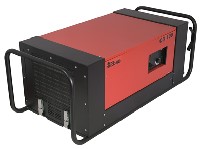
Ebac CD100 stationary dehumidifier on skid frame
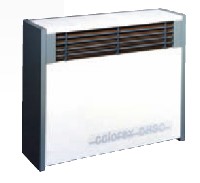
Calorex DH60 wall mounted dehumidifier
Filter
Performance of all dehumidifiers diminishes as dust builds up on the coils. Most are fitted with filters to minimise this problem but the speed which it happens will depend to an extent on the efficiency of the filter.
Some are coarse washable filters which are easy and cheap to maintain, whilst some may have disposable filters of slightly higher efficiency. Irrespective of the filter type, it is important for a permanent dehumidifier to have easily removable body panels so that access for cleaning and maintenance is easy.
Tamper Proof Controls
Some wall mounted dehumidifiers will find use in applications where it is important that controls are reasonably tamper proof, in order that the controls are not adjusted without reason. Some units do offer this feature.
Supplementary heating - LPHW or electric
In the general operation of dehumidifiers there is usually a lift in temperature of the processed air, in the order of 5 - 8°C. This can go some way to providing beneficial heat into the dehumidified air space, however for some applications more heating capacity will be required and it may make sense to provide this heat from the dehumidifier rather than separate heating appliances.
Supplementary heating is often available in some dehumidifier variants, and can either be in the form of an electric element or a LPHW water fed coil, the flow and return of which would be connected to the low pressure hot water system in the building. Depending on the size and model of the wall mounted dehumidifier, up to 9kw heating power can available.
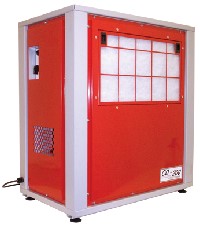
Ebac CD200 stationary dehumidifier
Air outlet / discharge options
Whilst most permanent dehumidifiers have a regular cabinet type construction with air movement in only one possible direction e.g. in the bottom and out at top front of cabinet, there are some models that offer more flexibility, with definite inlet and outlet plenums as part of the construction and interchangeable body panels, spigots or louvers, to enable air inlet and outlet direction to be selected to suit the application. This is useful as it means the dehumidifier, within reason, can be part of a ducted system and even accommodated in 'out of room' locations such as voids, stairwells and crawl spaces. If you're looking to browse our range of ducted dehumidifiers, simply click the link.
Wall Mounted Dehumidifiers With Continuous Drain
Floor and wall mounted dehumidifiers will be permanently linked to a drain. There are a number of things to consider here. The drain pan inside the dehumidifier needs to be easily accessible so that it can be cleaned and so the dust laden slime that can build up, can be easily removed. The connection to drain needs to have a trap and sufficient fall, and be of sufficient bore to prevent plugging. The actual outlet size from the dehumidifier is usually quite small, typically 10 or 15mm Ø, but is always sensible to feed the outlet into a larger bore as soon as practically possible. Clearing a 10cm length of small bore drain pipe is much easier than clearing a 10m length! We do not list all the various models that we can supply on this website, but some of the wall mounted dehumidifers can be seen via the button below.
If you need help identifying the most suitable machine to meet your particular dehumidification requirements, please call us on 0845 688 0112.

